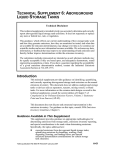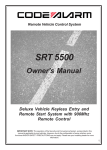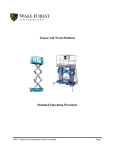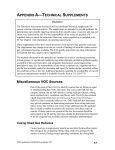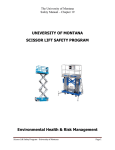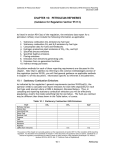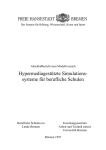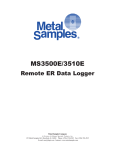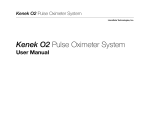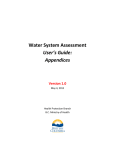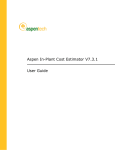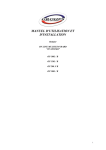Download "user manual"
Transcript
TECHNICAL SUPPLEMENT 6: ABOVEGROUND LIQUID STORAGE TANKS Technical Disclaimer This technical supplement is intended to help you accurately determine and correctly report aboveground liquid storage tank emissions. It does not supersede or replace any state or federal law, regulation, or rule. This guidance, which reflects our current understanding of how storage tanks work and how they generate emissions, how they are monitored or tested, and what data are available for emissions determination, may change over time as we continue our scientific studies and as new information becomes available. We welcome any data, information, or feedback that may improve our understanding of tank emissions and thereby further improve emissions inventory emission determinations. The represented calculation methods are intended as an emissions calculation aid; alternate calculation methods may be equally acceptable if they are based upon, and adequately demonstrate, sound engineering assumptions or data. If you have a question regarding the acceptability of a given emissions determination method, contact the Industrial Emissions Assessment Section at 512/239-1773. Introduction This technical supplement provides guidance on identifying, quantifying, and correctly reporting aboveground storage tank emissions on the annual emissions inventory. This document does not address underground storage tanks or devices such as separators, reactors, mixing vessels, or blend tanks. For more information on the common tank designs covered in this technical supplement, consult the current edition of Chapter 7 of Compilation of Air Pollutant Emission Factors, Volume 1: Stationary Point and Area Sources (AP-42). This document does not discuss tank structural representation in the emissions inventory. For guidance on this topic, consult 2005 Emissions Inventory Guidelines, Chapter 3. Guidance Available in this Supplement This supplement provides guidance on appropriate storage tank determination methodologies, emissions inventory reporting, and special considerations to be made when determining emissions. Specifically, the topics addressed are: # expected emissions from aboveground liquid storage tanks; TCEQ publication RG-360 # Revised # January 2006 A-59 Emissions Inventory Guidelines # quantifying emissions for breathing, working, flash, degassing, cleaning, and landing losses; and # special emissions determination considerations for certain storage tanks situations. Definition of Terms In this document, the term breathing losses, also referred to as standing losses, will refer to the emissions that occur when vapors are expelled from the tank due to temperature and/or barometric pressure changes. Cleaning will refer to the process of removing vapor, sludge, or rinsing liquid from a storage tank. Degassing is the process of removing organic gases or vapors from a storage tank. Equation of state will refer to an equation relating the temperature, pressure, and volume of a system in thermodynamic equilibrium. Flash gas refers to the gas or vapor that is generated when a gas and/or liquid stream experiences a decrease in pressure or an increase in temperature. Gas-to-oil ratio (GOR) means the number of standard cubic meters of gas produced per liter of crude oil or other hydrocarbon liquid. Landing losses refer to emissions that occur from floating-roof tanks whenever the tank is drained to a level where its roof rests on its deck legs (or other supports). Pigging (and its variants) refers to deploying a mobile plug (known as a pig) through a pipeline to perform various activities such as pipeline cleaning, inspection, or product removal. Working losses are emissions related to the movement of the liquid level in the tank. Working losses from fixed roof tanks occur as vapors are displaced from the tank during tank filling and emptying. Working losses from floating roof tanks occur as the liquid level (and therefore the floating roof) is lowered, causing the liquid on the exposed tank walls and fittings to evaporate. . Expected Emissions Storage tank emissions can include VOC, HAP, toxic, and inorganic emissions from flashing, landing, breathing, and working losses. Storage tank emissions may also include emissions from degassing, cleaning, and A-60 TCEQ publication RG-360 # Revised # January 2006 Technical Supplement 6: Aboveground Storage Tanks defective tank seals and fittings. All storage tank emissions, whether routine or non-routine, should be quantified and reported in the emissions inventory. Associated Emissions Equipment leak fugitive component emissions and loading loss emissions from trucks, railcars, tank cars, etc., are two other emissions sources generally associated with liquid storage operations. Do not report equipment leak fugitive components emissions at the same FIN/EPN path where storage tank breathing and working loss emissions are reported. Instead, report equipment leak fugitive component emissions at a separate path according to the guidance in Technical Supplement 3 of 2005 Emissions Inventory Guidelines. To determine emissions from equipment leak fugitive components, consult Technical Supplement 3 of 2005 Emissions Inventory Guidelines. Similarly, report do not report truck, railcar, tank car, etc., loading operations associated with storage tanks at the same FIN/EPN path where storage tank breathing and working loss emissions are reported. Instead, report the loading rack and its related emissions at an unique FIN/EPN path. For further guidance on structural representation, consult the “Loading Operations” section in 2005 Emissions Inventory Guidelines, Chapter 3. For guidance on determining emissions from loading operations, consult the current version of TCEQ Air Permits Technical Guidance for Loading Operations and the current version of AP-42, Chapter 5.2. Quantifying Storage Tank Emissions Determining Emissions from Breathing and Working Losses Emissions from storage tanks occur because of evaporative losses of the liquid during storage (breathing losses) and as a result of changes in liquid level (working losses). Determining breathing and working loss emissions from liquid storage tanks should be consistent with the current edition of AP-42, Chapter 7. Using the current version of TANKS, EPA’s free software program that calculates fixed and floating roof storage tank emissions, will help to ensure that emissions determinations are consistent with the current edition of AP-42. The current version of TANKS is available at: www.epa.gov/ttn/chief/efpac/efsoftware.html. TCEQ publication RG-360 # Revised # January 2006 A-61 Emissions Inventory Guidelines Annual and Ozone Season Emissions Annual and ozone season breathing and working loss emissions can be determined by using the current TANKS program or by following the guidance outlined in AP-42, Chapter 7. Due to higher average ambient temperatures during the ozone season, the vapor pressure of an organic liquid will increase; therefore, storage tank emissions rates will be greater in the summer than in the winter. Ozone season emissions will need to be determined using the increased vapor pressure data in the appropriate equations. Ozone-season emissions should be determined by generating a TANKS report for the months of June, July, and August. To obtain the ozone season pound per day (PPD) emissions rate, divide the total emissions (in pounds) for the three-month summer period by 92 days (the total number of days during the ozone season). Obtaining Accurate Emissions Determinations from TANKS Accurate data input is essential to obtaining valid emissions determinations from the TANKS program. TANKS has programmed default settings for many input variables, including floating roof tank fittings, and speciation profiles for chemical mixtures. Using these TANKS default settings instead of available site-specific information can result in inaccurate or invalid emissions determinations. Therefore, the user should use site-specific data to obtain the most accurate emissions determinations. Specifically, for compounds whose physical properties can vary widely, such as condensate, or for site-specific or proprietary compounds or chemical mixtures, enter specific chemical or mixture data into the TANKS chemical database; use this new chemical data to generate emissions reports. Similarly, detailed information on the number and physical characteristics of the tank fittings should be used in the “detailed” fittings selection should be used in the “Physical Characteristics” portion of TANKS. The TANKS user’s manual, available at: www.epa.gov/ttn/chief/software/tanks/tank4man.pdf, contains detailed instructions for adding or modifying chemicals, chemical mixtures, and tank fittings, as well as general information on how to use the software. Determining Emissions from Flashing Losses Flashing losses occur when a liquid with entrained gases experiences a pressure drop or a temperature increase. As the liquid equalizes to a new steady state, some of the lighter compounds dissolved in the liquid are released or “flashed” from the liquid. Additionally, some of the A-62 TCEQ publication RG-360 # Revised # January 2006 Technical Supplement 6: Aboveground Storage Tanks compounds that are liquids at the initial pressure/temperature transform into a gas/vapor and are also released or “flashed” from the liquid. As these gases are released, some of the other non-flashing compounds in the liquids may become entrained in these gases and will be emitted with them. Flashing loss emissions (flash emissions) are greater as the pressure drop increases and as the amount of lighter hydrocarbons in the liquid increases. The temperature of both the liquids and the storage tank will also influence the amount of flash emissions. From a process perspective, flash emissions from storage tanks generally occur when pressurized liquids are sent to storage operations at a lower pressure. Specifically, flash emissions from storage tanks can occur at wellhead sites, tank batteries, compressor stations, gas plants, and “pigged” gas lines when pressurized gas and liquids are sent to atmospheric storage vessels. These flash emissions are vented to the atmosphere through a tank’s pressure relief valve, hatch, or other openings, or, alternatively, may be routed to a control device. Additionally, flash emissions can also be associated with high, intermediate, and low pressure separators, heater treaters, surge tanks, and accumulator operations, although emissions determinations for these sources are not addressed in this supplement. While the composition of flash emissions varies, flash gas emissions include VOCs, HAPs, and toxics. Emissions Determination Methodologies: Order of Preference Several different methods of determining flash emissions exist; however, there are specific constraints associated with each method. The most appropriate method for determining flash emissions will depend upon the site-specific process. Acceptable determination methods for a given process should be evaluated upon whether the process parameters are consistent with the method’s development and underlying assumptions. General orders of preference for black oil and gas condensate systems are listed below. However, for a given system, a more preferred method may not necessarily be applicable to a process based upon its specific parameters. Specific constraints for each method are explained in detail in the following sections. If the IEAS determines that a determination method for a site-specific process is unfounded, then the IEAS may require that the emissions determinations be recalculated using a more appropriate method. Note that EPA TANKS does not determine flash loss emissions, and cannot be used to determine losses from unstable or boiling stocks, or from mixtures of hydrocarbons or petrochemicals for which the vapor pressure is not known or cannot be readily predicted. TCEQ publication RG-360 # Revised # January 2006 A-63 Emissions Inventory Guidelines Black Oil Systems The appropriate flash emissions determination methodologies for black oil systems are, in general order of preference: # direct measurement of emissions (code as “M”); # process simulator models (code as “S”); # E&P TANK program (code as “O”); # Vasquez-Beggs or Rollins, McCain, and Creeger correlations, or software that uses these correlation equations (such as GRIHAPCalc) (code as “O”); # Gas/oil ratio (GOR) method, as described below (code as “B”). Gas Condensate Systems The appropriate flash emissions determination methodologies for gas condensate systems are, in general order of preference: # direct measurement of emissions (code as “M”); # process simulator models (code as “S”); # E&P TANK program (code as “O”); # Environmental Consultants and Research, Inc. (EC/R) Equation (code as “O”); # Gas/oil ratio (GOR) method, as described below (code as “B”). Direct Measurement of Emissions Direct measurement provides the most accurate results for evaluating flash gas flow rates and flash emissions composition; however, this method can be more costly than other methods discussed below. EPA-approved reference methods should be used to determine and characterize flash emissions. However, it should be noted that such testing is just a snapshot of the flash gas emissions at the test conditions and does not address variability over time. Process Simulator Models Process simulators are computer models that use equations of state in conjunction with mass and energy balances to simulate petroleum processes for a variety of engineering purposes. Process simulator determinations generally are consistent with laboratory values, and therefore are expected to be more accurate when estimating flash emissions than most other determination methods (except measurements). However, process simulators are costly, and can be complicated to use. There are several different process simulators (HYSIM®, HYSIS®, WINSIM®, PROSIM®, etc.), each utilizing similar basic principles. While process simulators are primarily used in process design, these models can also determine and speciate flash emissions using the A-64 TCEQ publication RG-360 # Revised # January 2006 Technical Supplement 6: Aboveground Storage Tanks Peng-Robinson equation of state option. Although other equations of state are available in the model, the Peng-Robinson equation best suits flash emissions determinations. Required inputs may include an extended pressurized condensate analysis as well as other parameters (for example, temperature, pressure, and flow) for the process being simulated. Unlike other flash determination methods, process simulators are not constrained by American Petroleum Institute (API) gravity. Process simulators are appropriate for either black oil or gas condensate systems if detailed, accurate input data are available. E&P TANK Program API and the Gas Research Institute (GRI) developed the E&P TANK model, which predicts VOC and HAP emissions (flashing, working, and standing losses) from petroleum production field storage tanks. The E&P TANK program bases flash emissions determinations on the Peng-Robinson equation of state, and requires site-specific information to determine emissions rates. E&P TANK is best suited for upstream operations, such as stock tanks at wellheads and tank batteries common to several wellheads, although it will handle a broad range of API gravities (15°-68°). The E&P TANK model allows the user to input compositional analyses from pressurized oil and gas samples to simulate flash generation in storage tanks. Specifically, the minimum inputs needed for the model are: # separator oil composition; # separator temperature and pressure; # sales oil API gravity and Reid Vapor Pressure (RVP); # sales oil production rate; and # ambient temperature and pressure. Since separator oil composition is a key input in the model, E&P TANK includes a detailed sampling and analysis protocol for separator oil. E&P TANK also allows users to input detailed information about tank size, shape, internal temperatures, and ambient temperatures, and therefore the software can produce more precise emissions determinations. This flexibility in model design allows users to employ the model to match sitespecific information. TCEQ publication RG-360 # Revised # January 2006 A-65 Emissions Inventory Guidelines Vasquez-Beggs Correlation Equation The Vasquez-Beggs correlation equation was developed in 1980 as part of an University of Tulsa research project. More than 6,000 samples from oil fields worldwide were used in developing correlations to predict oil properties. The Vasquez-Beggs correlation equation determines the gas/oil ratio (GOR) of a hydrocarbon solution from user-inputted variables; this GOR can then be used in conjunction with product and process parameters to determine flash emissions. This method was designed for gases dissolved in crude oils, and is most appropriate for use on upstream operations, such as stock tanks at wellheads, oil and gas production batteries, and for "black oil" (a heavy, low-volatility oil approximated by a gas to oil ratio of less than 1750 cubic feet and an API gravity less than 40 degrees). The method requires eight input variables: # stock tank API gravity, # separator pressure, # separator temperature, # gas specific gravity, # volume of produced hydrocarbons, # molecular weight of the stock tank gas, # VOC fraction of the tank emissions, and # atmospheric pressure. The Vasquez-Beggs correlation equation determines the dissolved GOR of a hydrocarbon solution as a function of the separator temperature, pressure, gas specific gravity, and liquid API gravity. Flash emissions from the VOC storage tank are then determined by multiplying the GOR by the tank throughput, the stock tank gas molecular weight, and the weight fraction of VOC in the gases. These equations to determine flash emissions are available in a Microsoft EXCEL® spreadsheet originally developed by the Oklahoma Department of Environmental Quality (DEQ), and can be downloaded from the Web at: http://www.deq.state.ok.us/AQDnew/resources/Calculations11.xls. Programs such as GRI’s HAPCalc ® model use the Vasquez-Beggs correlation equation to determine flash emissions; emissions determinations methods using such programs should be coded accordingly. EC/R Equation The EC/R equation calculates flash emissions based on: the pressure drop of the process stream from the previous process vessel, the tank A-66 TCEQ publication RG-360 # Revised # January 2006 Technical Supplement 6: Aboveground Storage Tanks throughput, the density of the hydrocarbon liquids, and the mass fraction of each component in the liquid. This method assumes that the liquid and vapor streams reach equilibrium at standard temperature and pressure and that the storage tank is at standard temperature and pressure. The EC/R algorithm is valid for vapor pressure of liquid streams entering the storage tank between 1.6 atmospheres (atm) and 5.1 atm. At vapor pressures less than 1.6 atm or greater than 5.1 atm, another method should be selected. The EC/R equation is best suited to gas condensate systems operating in the pressure ranges described above. This equation is available in a Microsoft EXCEL® spreadsheet originally developed by the Oklahoma DEQ, and can be downloaded from the Web at: http://www.deq.state.ok.us/AQDnew/resources/Calculations11.xls. Gas/Oil Ratio (GOR) Method Determination of the hydrocarbon liquid GOR can be obtained by laboratory analysis of a pressurized sample collected upstream of the storage tank from the separator dump line (or from a similar apparatus). For more information, refer to the Gas Processors Association (GPA) Standard 2174-93, which provides details on sampling procedures for collecting a pressurized oil sample. The flash emissions are then determined by multiplying the GOR by the throughput of the tank. An extended hydrocarbon analysis of the flash gas from the sample should also be conducted to identify the concentrations of the individual components of the tank’s flash emissions. When such sampling is conducted, the GOR method is appropriate for either black oil or gas condensate systems. Determining Emissions from Landing Losses Landing losses occur from floating-roof tanks whenever the tank is drained to a level where its roof rests on its deck legs (or other supports). Emissions occur while the roof is landed and also as the tank is refilled. Currently, no storage tank emissions software, including EPA’s TANKS program, determines landing loss emissions as part of routine program operation. When a floating roof lands on it supports or legs, it creates a vapor space underneath the roof. Liquid remaining in the bottom of the tank provides a continuous source of vapors to replace those expelled by breathing (in the case of internal floating roof tanks) or wind action (in the case of external floating roof tanks). These emissions (referred to as standing idle losses) occur daily as long as the tank roof remains landed. TCEQ publication RG-360 # Revised # January 2006 A-67 Emissions Inventory Guidelines Additional emissions occur when incoming stock liquid fills a tank with a landed roof; the incoming liquid not only displaces those vapors remaining under the floating roof, but also generates its own set of vapors that are displaced during the filling process. These two types of emissions are collectively referred to as filling losses. For a given roof landing event, total landing loss emissions are therefore the sum of the daily standing idle losses and the filling losses over the entire period that the roof remained landed. Landing losses are inherently episodic in nature, and must be determined each time a tank’s floating roof is landed. The emissions determination method detailed in API TR 2567, Evaporative Loss from Storage Tank Floating Roof Landings, or its equivalent, is the preferred method for determining landing loss emissions. This publication is available from API. Determining Emissions from Degassing and Cleaning Operations Emissions from tank degassing and cleaning operations can be determined using site-specific knowledge and material balance equations. Alternatively, the following methods developed by the EPA can be used to determine emissions. Degassing (Emptying) a Storage Tank For a fixed roof tank, degassing emissions can be determined by a twopart process. First, use TANKS to determine emissions from one turnover to account for vapors displaced during filling. Next, to account for clingage, determine the emissions from one turnover calculated as if the tank had an internal floating roof. Sum these two emission rates to determine degassing emissions. For a floating roof tank, degassing emissions can be determined by a twopart process. First, use TANKS to determine emissions for one turnover. Next, to approximate the vapor displaced from the space under the floating roof, determine the emissions from the tank modeled as a fixed roof tank with a tank height equal to the height of the deck legs. Sum these two emission rates to determine degassing emissions. Cleaning (Sludge Handling) Most aqueous sludges are about 80% to 90% water by weight. A conservative approach for determining emissions from sludge cleaning is to assume the sludge is 80% water; the remainder is assumed to be VOC A-68 TCEQ publication RG-360 # Revised # January 2006 Technical Supplement 6: Aboveground Storage Tanks and emitted. As an alternative, the actual sludge moisture content can be determined. Special Considerations when Quantifying Emissions When determining storage tank emissions, note the following special considerations. Pressure Tanks Pressure tanks are designed to handle pressures significantly higher than atmospheric pressure. Two classifications of pressure tanks exist: low pressure and high pressure tanks. API defines low pressure tanks as those operating in the range of just above atmospheric pressure to 15 psig; high pressure tanks are those operating at pressures above 15 psig. High pressure tanks are considered to be closed systems that prevent routine breathing and working loss emissions. However, routine emissions from equipment leak fugitive components associated with high pressure tanks, as well as any non-routine emissions, should be reported in the EI. Low pressure tanks can experience breathing and working losses. While these emissions are usually less than those a similar atmospheric tank would experience, these emissions should be quantified and reported within the EI according to the guidance outlined in Chapters 3 and 4 of 2005 Emissions Inventory Guidelines. Since the TANKS model uses equations developed under atmospheric conditions, it does not accurately model emissions from low pressure tanks. Instead, you may use API Bulletin 2516, Evaporation Loss From Low-Pressure Tanks, to determine breathing and working losses from low pressure tanks. Nitrogen-Blanketed Tanks Typically, storage tanks are blanketed with nitrogen (or other inert materials) to reduce the risk of fire, to reduce water acquisition by hygroscopic materials, or to prevent corrosion. However, nitrogen blanketing of an atmospheric storage tank does not reduce the tank’s breathing or working loss emissions (note: air is composed of approximately 78% nitrogen by volume). Therefore, when determining emissions from nitrogen-blanketed atmospheric storage tanks (whether the tank is of fixed roof or internal floating roof design), no modifications to the AP-42 equations (or software programs using these equations) are required. The gas blanket will not affect emissions if the tank is operated near atmospheric pressure. TCEQ publication RG-360 # Revised # January 2006 A-69 Emissions Inventory Guidelines Heated Tanks If a tank is heated, the vapor space can be assumed to be at a constant temperature and no breathing losses will occur. The tank must be heated to a uniform temperature and well insulated, thus isolating it from heat gains and losses due to insolation and variations in ambient temperature. Changes in atmospheric pressure are assumed to have only negligible contributions to breathing losses and are not considered. When using the TANK program, the menu selection "Is Tank Heated" on the Physical Characteristics screen should be answered "Yes" to determine emissions from vertical and horizontal fixed roof tanks. This will allow you to enter the temperature data directly on the Tank Contents screen. Temperature data input fields exist for Average, Minimum and Maximum Liquid Surface Temperature and for Bulk Liquid Temperature (degrees Fahrenheit). The temperature at which the tank is heated should be entered in all four data fields. If the tank is not well insulated, daily variations in liquid surface temperatures may be observed. The Minimum and Maximum Liquid Surface Temperatures, if available, should be input to estimate breathing losses. You should also ensure that TANKS has the appropriate data to estimate vapor pressure at the desired temperature in its chemical database information. For example, if TANKS uses Option 1 in the chemical database for estimating vapor pressure (which is valid for the temperature range from 40 to 100 °F) and the desired temperature is over 100 °F, the program will not extrapolate the vapor pressure to the higher temperature , but will instead calculate a vapor pressure at 100 °F. Options 2, 3 or 4 in the chemical database should be used for estimating vapor pressures at temperatures greater than 100 °F. Tanks Storing Inorganic Liquids Currently, methods developed exclusively for determining inorganic compound emissions from storage tanks do not exist. However, it is possible to use the TANKS model to determine storage tank emissions from inorganic liquids if the inorganic liquid has a measurable vapor pressure and vapor pressure data are available for one of the vapor pressure options in the TANKS chemical database. Although the equations used in TANKS the model were developed to estimate evaporative losses from storage of organic liquids, they currently present the best available method to determine inorganic emissions from storage tanks. A-70 TCEQ publication RG-360 # Revised # January 2006 Technical Supplement 6: Aboveground Storage Tanks Speciation If you have any source-specific information about storage tank VOC composition, you should use it to speciate the emissions. Supply the composition data and any related information (such as test results, etc.) with your emissions inventory. If you do not have any source-specific information about storage tank VOC speciation, then you should use the default speciation profiles in the current TANKS program. For more information on speciation requirements, see 2005 Emissions Inventory Guidelines, Chapter 4. Supporting Documentation Provide supporting documentation with your emissions inventory that supports and validates the emissions reported in the inventory. The relevant supporting documentation includes, but may not be limited to, representative samples of the following types of data: # sample calculations detailing the tank parameters (diameter, height, shell color, roof color, paint condition, shell construction, capacity, primary/secondary seals, tank fittings, and throughput rate); # if TANKS is used, a report generated using the “detailed” report option; # physical properties of the product(s), including liquid density, liquid molecular weight, vapor molecular weight, and vapor pressure; # sampling analysis; # all supporting data used to calculate the flash losses, including identification of the determination method, sample analysis, API gravity, the density of liquid petroleum, gas/oil ratio, gas gravity, molecular weight of stock, VOC weight percent of both the stored liquid and flash gas; and # all other information necessary to determine emissions. Frequently Asked Questions Frequently asked questions about storage tanks are available on EPA’s website at: www.epa.gov/ttn/chief/faq/tanksfaq.html. While these questions are not reproduced here due to space considerations, they address such topics as underground storage tanks, vapor balanced tanks, tanks with roof geometries other than a cone or a dome, indoor storage tanks, and tanks storing a two-phase liquid. TCEQ publication RG-360 # Revised # January 2006 A-71 Emissions Inventory Guidelines References Air Permits Technical Guidance for Chemical Sources: Storage Tanks. TCEQ draft document: February 1995. “Calculation of Flashing Losses/VOC Emissions from Hydrocarbon Storage Tanks.” July 19, 2004. Online. Oklahoma Department of Environmental Quality. http://www.deq.state.ok.us/factsheets/air/CalculationLosses.pdf Compilation of Air Pollutant Emission Factors, Volume I. Stationary Point and Area Sources 5th edition, AP-42,. U. S. Environmental Protection Agency, Research Triangle Park, North Carolina, 1995. “Correlations for Fluid Physical Property Prediction.” Study by Milton Vasquez and H. Dale Beggs, Published in Journal of Petroleum Technology, March 1980. EPA. “The Natural Gas STAR Partner Update– Fall 2004.” September 1, 2004. Online. EPA Natural Gas STAR Program. http://www.epa.gov/gasstar/pdf/fall2004update.pdf. New Mexico Environment Department. “Air Quality Bureau: Frequently Asked Questions.” March 10, 2005. Online. New Mexico Environment Department. http://www.nmenv.state.nm.us/aqb/FAQ.html#fl1. Preferred and Alternative Methods for Estimating Air Emissions from Oil and Gas Field Production and Processing Operations, EPA: Emissions Inventory Improvement Program Document Series, Volume II, Chapter 10: September 1999. A-72 TCEQ publication RG-360 # Revised # January 2006














